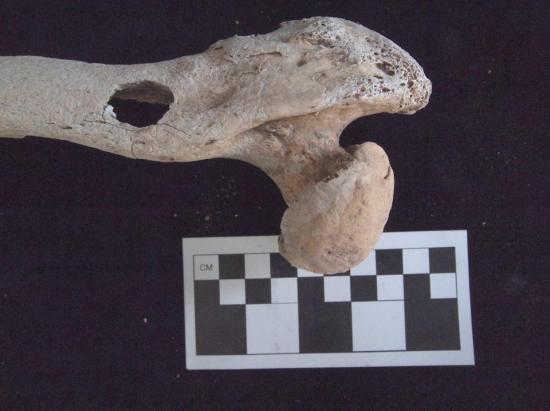Kristina Killgrove
Source - http://www.forbes.com/sites/kristinakillgrove/2017/01/12/ancient-skeleton-yields-earliest-diagnosis-of-legg-calve-perthes-disease-in-china/#693921e177af
 Right proximal femur of young man with Legg-Calvé-Perthes disease in a Shaanxi Province cemetery from Warring States period China. (Photo by Elizabeth Berger and used with permission.)
Right proximal femur of young man with Legg-Calvé-Perthes disease in a Shaanxi Province cemetery from Warring States period China. (Photo by Elizabeth Berger and used with permission.)
Some time between the 5th and 3rd centuries BC, a young man was buried in a simple cemetery in Shaanxi Province, China. His mushroom-shaped hip, though, is far from common -- it gives us the first diagnosed case of Legg-Calvé-Perthes disease in all of China.
The cemetery in question contained the graves of two different cultural groups interred during China's Warring States period (475-221 BC). Low-status subjects of the state of Qin were buried around the edges of the cemetery, while graves of the Rong, who migrated to Shaanxi from western China, formed the dense center of the burial ground. This is the first Rong cultural site found in Shaanxi Province, excavated by researchers at the Shaanxi Provincial Archaeological Research Institute, with the investigation of the remains funded in part by the National Geographic Society.
But one particular skeleton in a Rong grave is the subject of a new article in the International Journal of Paleopathology by University of North Carolina bioarchaeologist Elizabeth Berger and her colleagues Liang Chen of Northwest University and Zhouyong Sun and Zhanwei Sun of the Shaanxi Institute.
The young man, who died in his 20s, presented a host of skeletal issues. Osteoarthritis of numerous joints, odd muscle attachments on some limb bones, a fatigue fracture in his lumbar spine and possible evidence of anemia in his skull all add up to a tough, short life. The most impressive bony deformity, though, was in his right leg, where the head of his femur -- the ball part of the hip ball-and-socket joint -- looked mushroom-like.
Berger and colleagues interpret this as Legg-Calvé-Perthes disease (LCPD), which is an abnormality of bone development in childhood that involves interruption of the blood supply to the head of the femur. When that end of the bone -- which is separate in childhood to allow for growth -- is deprived of blood, it does not grow normally. Often, the blood supply is eventually restored, which causes the bone to start growing again, but which leaves the person with a permanent deformity of the bone.
The causes of LCPD are currently not well known in the medical literature, but can be related to traumatic injury and is much more commonly seen in males. Berger tells me that, although no settlement has been found associated with this cemetery, during this time period the Rong were agricultural-pastoralists. This means that the young man -- called SHSM22 in the article -- could have been injured as a child while helping with food production.
Interestingly, Berger and colleagues also found changes to the man's left leg. Specifically, his lower leg and ankle bones were enlarged and showed evidence of strong muscle attachments. Because SHSM22 would have been favoring his right side, these left-sided issues show that, although he had "somewhat impaired mobility, as well as chronic inflammation in the lower leg, he likely continued to participate in his community's labor activities," Berger and colleagues write in their article.
 Left and right tibiae of young man with Legg-Calvé-Perthes disease from Warring States period China. (Photo by Elizabeth Berger and used with permission.)
Left and right tibiae of young man with Legg-Calvé-Perthes disease from Warring States period China. (Photo by Elizabeth Berger and used with permission.)
Within the cemetery, there are other people with traumatic injuries, Berger tells me -- two with healing rib fractures and one with a collarbone fracture, three with compression fractures in the spine, and two people with a lumbar spine fatigue fracture like SHSM22 had. "The terrain is pretty steep in this area, with lots of gullies and mountain paths," Berger explains, "so they would likely have been doing a lot of strenuous walking and carrying heavy loads."
What surprised Berger the most about this Shaanxi cemetery, though, was the low frequency of violent injuries. "In this area, the Qin and Rong ethnic groups lived side-by-side under the Chinese state, at the end of the Warring States period, which you would expect to mean lots of violence. But the people buried here don't appear to have been directly involved in warfare or conflict -- there was only one individual with a healing depressed fracture on his frontal bone," she notes.
As this is the first Rong cultural site discovered in Shaanxi Province, the cemetery will certainly produce more clues to this important time period of Chinese history in the near future.